“Walker, your footprints are the path and nothing else; walker, there is no path, the path is made by walking…” In some way, this poem by Antonio Machado reflects very well the Camino de Santiago, the thousand-year-old Christian pilgrimage that every year it continues to attract crowds of people from all over the world, who leave their homes for a week or even for months, to leave their tracks on the paths of beaten earth, mud, stones, old Roman roads and villages that make up the route sacred. The couple formed by Rosa de la Guía and Tomás Mazuecos chose the Xacobeo Year to do the Camino de Santiago as a couple, but yes, “walking, as it should be”, said with conviction.

‘Suffer and share’ the Camino de Santiago together
Although all roads lead to the Cathedral of Santiago de Compostela, in Galicia, where the remains of the Apostle Santiago are found, there are many reasons that lead people to do the Camino, although in the end “it is something very personal”, according to Rosa. And he explains: “We were moved by faith, the attraction to nature, adventure and to think that we were doing something that millions of people had already done. It is a good occasion to reflect, remember, forget, pray, feel, listen, suffer, share…”
Parents on the Camino with their children and the house under control
The Camino de Santiago does not always begin with the first step along the path. For this couple who have three daughters, it began a couple of months before, with the preparation, not only seeking information about what the Camino entails, but also to leave the house and the daughters well assisted… “all a lace of bolillos!”, as they explain. Rosa and Tomás chose the month of April to do the Camino because they believe that spring and autumn are the best times, mainly for those who choose hostels to sleep; They are not open year round.
For the Camino, the luggage must consist of the minimum possible. A couple of changes and little else. In the shelters you can wash clothes every day. And if it doesn’t give it time to dry, people carry it hanging in their backpacks.
The footwear to do the Camino
If something is important, according to the couple, it is that the footwear is not new and is already used to the pilgrim’s feet. It is best to wear trekking shoes. It is also recommended to spread Vaseline on your feet every day before starting the route, to avoid blisters. Wear sandals to rest your feet at the end of each stage and have a good first- aid kit on hand with betadine, band-aids… it’s appreciated. As for the expenses, it all depends on the hunger and the level of demand of each one to sleep. There are hostels that can charge only 3 euros a night, and there are roads where you can find markets and very cheap lunches. The saying “God helps those who get up early” is quite true on the Camino, because those who get up early get to sleep in the hostels. If someone is late, he will have to find another place to sleep. “Although sleeping in shelters is more uncomfortable, it can be enriching,” says Rosa.
Rosa advises carrying the credential that identifies walkers as pilgrims. With this Pilgrim Passportthe stamps are collected in the cities and towns through which it passes. The accreditation gives the right to access the hostels and thus, on arrival in Santiago de Compostela, prove that you have completed the minimum journey to be entitled to the Compostela, which is the certificate of having completed the Camino. The only ones entitled to the Compostela are the pilgrims who manage to complete a minimum of 100 km on foot or 200 km by bicycle.
The French Way was chosen by the couple
The route chosen by the couple was the French Way that leaves from Sarriá, 115.3 km from Santiago de Compostela. According to the couple, this is the most prepared because it is very well signposted, offers many services and shelters to sleep.
And between ups and downs, between forests and trails, this was Rosa and Tomás’ journey:
Departure from Madrid on a night train at 10:30 p.m.
Arrival in Sárria at 6:37 in the morning.
Stage from Sárria to Portomarín – 23 km
Stage from Portomarín to Palas de Rei – 25 km
Stage from Palas de Rei to Arzúa – 28.8 km
From Arzúa to O Pedrouzo – 19.1 km
From O Pedrouzo to Santiago – 20km
On arrival in Santiago de Compostela, excitement overcomes fatigue
The last kilometers of the Camino are done through the city of Santiago. For Rosa, her arrival made her feel a strange sensation. She wanted to get there so badly that when she reached the finish line she felt a little sad when she did. And what’s more, “when you return home, you realize that the Camino really begins when you arrive in Santiago.”
